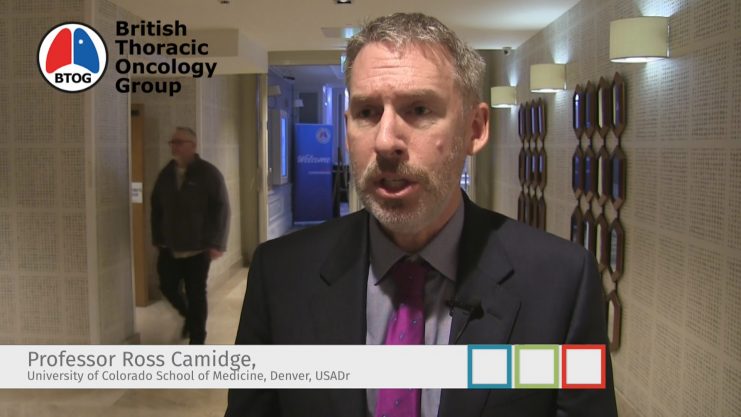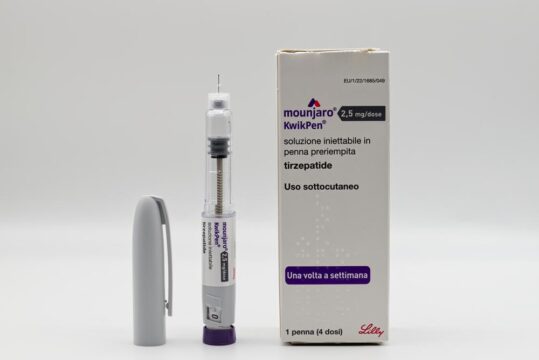Advertisment
Translational oncology symposium

The use of tyrosine kinase inhibitors (TKIs) in the treatment of ALK-positive NSCLC is now well-established. Professor Ross Camidge (University of Colorado Cancer Centre, Denver, USA) described the lessons that have been learned in relation to TKI-resistance.
Interview by Esther Drain. Article by Christine Clark.
Professor Ross Camidge (Denver, USA) and Dr Alastair Greystoke (Newcastle, UK) discuss TKI resistance and adoptive T-cell therapy for solid tumours.
The first TKI inhibitor, crizotinib, penetrated the brain poorly – five hours after administration only 0.03% of the dose was detectable in brain – and brain lesions responded correspondingly poorly. It soon became clear that the presence of a brain lesion and its response to treatment had a major influence on overall outcomes and pointed to the need for “formal two-compartment data presentations”, said Prof Camidge. Robust CNS efficacy data were needed but capturing the data appropriately was problematic – for example, in the past published reports did not always separate treated brain metastases from untreated or distinguish those who received whole brain radiation (WBRT) from those who received stereotactic radio surgery (SRS). “Like-with-like comparisons were hard to ensure”, he commented.
Another observation was that lorlatinib (post-crizotinib or other TKI inhibitor) gave consistently better overall response rates (ORRs) in brain lesions than in extracranial sites. It was not known whether this was because pre-treatment with a drug that did not penetrate the CNS meant that the brain was effectively ’treatment naïve’ and hyper-responsive or because of some other factor. Now that CNS-penetrating drugs are being used more frequently the emergence of TKI-resistant tumours in brain can be expected.
ALK mutation profiles differ according to the treatment given; after ceritinib or alectinib 56% of patients have ALK mutations but 21% of ceritinib-resistant tumours have G1202R mutations and 29% of alectinib-resistant tumours have G1202R mutations. The I1171 is seen in 12% of alectinib-resistant tumours but it is not seen at all in ceritinib-resistant tumours. Moreover, different resistance mutations have different sensitivities to the available ALK inhibitors.
Some of the unexplained effects may be due to “off-target effects”, suggested Prof Camidge. Researchers have become adept at examining effects on ALK mutations but other ‘second drivers’ may be relevant. For example, ceritinib, lorlatinib and brigatinib are known to inhibit ROS1 and brigatinib is also active against EGFR. These effects could explain why lorlatinib and brigatinib achieve consistently longer median progression free survival (PFS) times than other next-generation TKIs. These “off-target effects” will be one of the important areas for future research, he concluded.
The FLAURA trial compared first line osimertinib against a first-generation EGFR- TKI. The early results showed that CNS progression events occurred 6% of patient taking osimertinib compared with 15% of those taking standard of care (SoC) treatment. However, a detailed analysis of the patients who had measurable CNS disease at baseline shows that the durations of response (DoR) did not differ between osimertinib and the SoC EGFR-TKI. It is not clear whether the levels of osimertinib in the CNS were sufficient to elicit a response in more patients but not high enough to exert an effect against the T790M mutation or whether the T790M mutation is not a problem in the CNS, said Prof Camidge.
Adoptive cell therapy for solid tumours
“Cell therapy is coming down the line for investigation in lung cancer and other solid tumours”, according to Dr Sophie Papa, (Consultant Medical Oncologist, Kings College Hospital, London). Cell therapy has been used in haematology/oncology to control tumours for many years; for example, donor lymphocyte infusions. Now there are other possibilities.
One approach is the use of tumour infiltrating lymphocytes (TILs). This involves isolating tumour infiltrating lymphocytes from a piece of tumour tissue, growing them in vitro and then re-infusing them into the patient. In future, TILs might be used to target neo-antigens in lung cancer, she suggested.
Another approach is chimeric antigen receptor (CAR)-T cells, which are produced by attaching a synthetic antigen receptor to the patient’s own T-cells. This enables recognition of antigens on tumour tissue and killing of cells. Early CAR-T cells produced a short-lived response but the technology has now matured to the point where interaction with the antigen not only brings about killing of tumour cells but also triggers activation and expansion of T-cells and consequent perpetuation of the response.
CAR-T cell therapy has been used successfully in leukaemia and diffuse large B cell lymphomas. There are now two licensed products – tisangenlecleucel (Kymriah™) and axicabtagene ciloleucel (Yescarta™). There is some evidence of efficacy in synovial carcinomas and glioblastomas. However, numerous challenges remain, including issues of efficacy, toxicity and practical organisation. Cytokine release syndrome (CRS) – reported in 77% of patients in some studies – and immune effector cell associated neurotoxicity syndrome (ICANS) are two serious adverse events that can occur. In addition to expense, a large team of people and departments is required to ensure timely and safe harvesting of T cells, transport, engineering and administration of CAR-T cell therapy.
Targeting KRAS
Professor Ross Camidge (Denver, USA) also discusses if targeting KRAS is hopeless or hopeful?
KRAS mutations could be driving 30% of adenocarcinomas of the lung and new agents that target KRAS could offer a useful approach to treatment, according to Professor Udai Banerji (The Royal Marsden NHS Foundation Trust). (KRAS is a protein which is involved in cell signalling pathways that control cell growth, cell maturation, and cell death.)
About 30% of lung adenocarcinomas carry mutated KRAS genes and the pattern of mutation is different from that seen in other common cancers. Early attempts to target KRAS with farnesyl transferase inhibitors were unsuccessful due to escape mechanisms. New approaches include drugs that target mutant KRAS, PROTAC and anti-sense oligonucleotide inhibitors that inhibit both wild type and mutant KRAS. KRAS inhibitors, such as AMG510 and MRTX849, block KRAS G12C, the most commonly found KRAS mutant in lung adenocarcinomas. Therapeutic antisense oligonucleotide AZD4785 blocks mutant KRAS at a lower dose than wild type KRAS. A KRAS PROTAC (proteolysis-targeting chimeric molecule) – a chimeric molecule that selectively targets and degrades KRAS – has been shown to inhibit tumour growth in a mouse model.
Another approach is to target downstream effectors of KRAS e.g. MEK and this is area that is currently being investigated. Professor Banerji concluded that KRAS could be a useful therapeutic target and represents a promising area of research.
Based on presentations given at the 17th Annual BTOG Conference, Dublin, January 2019.





